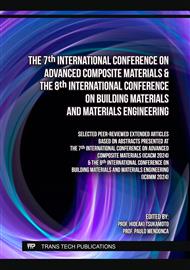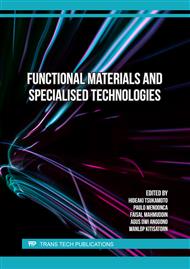p.23
p.33
p.39
p.47
p.55
p.61
p.67
p.73
p.83
Nito “Core” Fiber-Reinforced Epoxy Composites: Enhancing Properties with NaHCO3 Treatment
Abstract:
This study explores the use of sodium bicarbonate-treated Nito core fiber as a natural and eco-friendly alternative for fiber-reinforced composites to address the challenge of enhancing the mechanical properties of composite materials while also prioritizing environmental sustainability. Nito core fibers were treated with different concentrations of sodium bicarbonate, an economical and eco-friendly alternative to alkali treatment, to enhance its compatibility with various matrices. FTIR results showed that NaHCO3 treatment effectively removed and reduced some non-cellulosic components present in the Nito fiber such as hemicellulose and lignin. This resulted in the NaHCO3-treated fiber-epoxy composite showing better tensile strength and modulus of elasticity than the epoxy composite reinforced with untreated Nito fiber. The use of treated fiber, however, did not have a noticeable effect on the flexural strength and flexural modulus of the epoxy composite. The SEM images of the nito fiber-epoxy composites showed better fiber-matrix adhesion between the treated nito fiber and epoxy matrix. Thermogravimetric analysis (TGA) of nito fiber-epoxy composites shows that the thermal stability of the composite is mainly due to the presence of cellulose, which can also be enhanced by some lignin. This study, therefore demonstrates the potential of Nito ‘core’ fibers as a viable substitute for synthetic reinforcements that can contribute to the advancement of composite material technology that aligns with the global shift towards environmentally responsible manufacturing practices.
Info:
Periodical:
Pages:
55-60
Citation:
Online since:
December 2024
Price:
Сopyright:
© 2024 Trans Tech Publications Ltd. All Rights Reserved
Share:
Citation:



